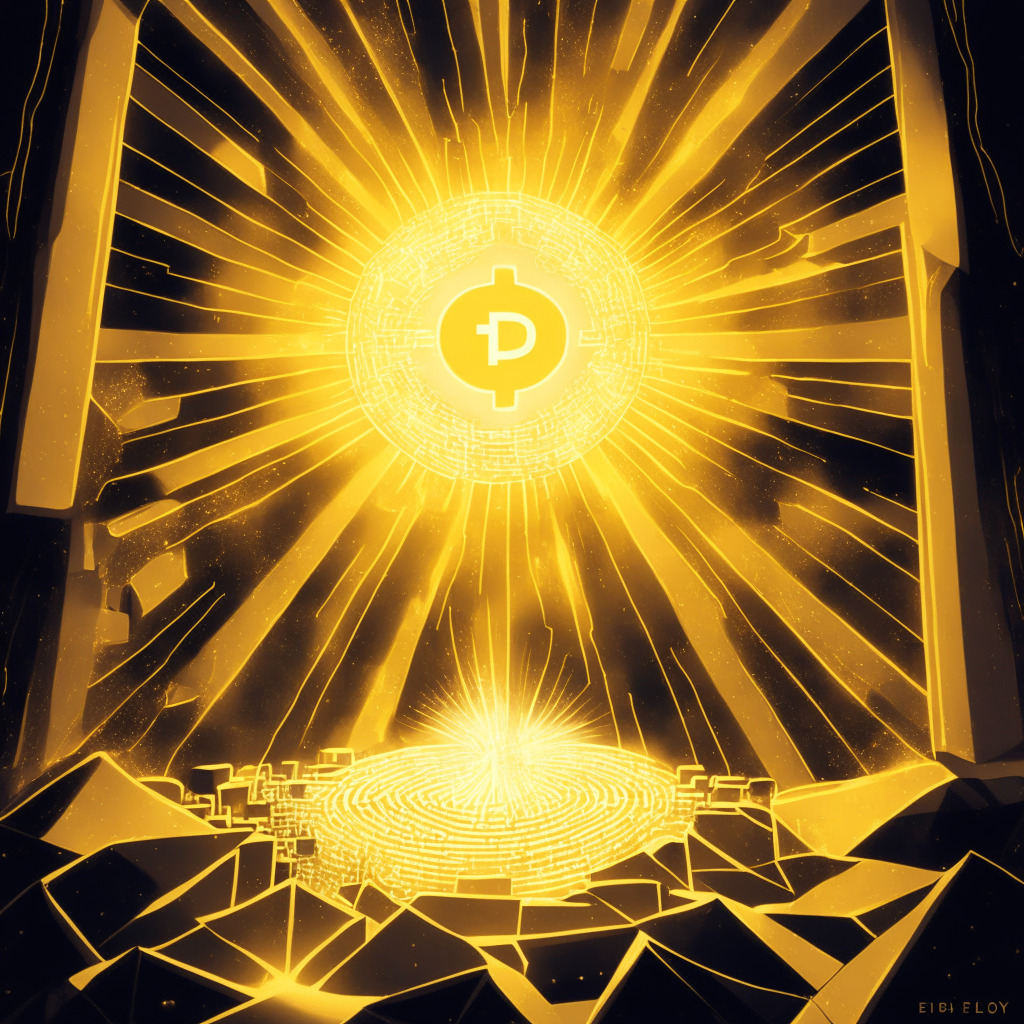“Ordinals, a method of registering digital content on the Bitcoin network, are seen as disruptive by some. However, analytics firm Glassnode finds little proof that they’re causing network congestion. Despite concerns, these bitcoin ‘pocket fillers’ seem to coexist with other money transfers, leveraging cheap block space without greatly impacting transfer volumes.”
Search Results for: Pi Network
Bitcoin Ordinals: Evaluating Impact on Network Efficiency Amid Rising Concerns
“The recent rise of Bitcoin Ordinals, a data inscription system, has raised concerns about network clogging and its impact on higher-value transactions. Contrary to this belief, a report by Glassnode found that inscriptions only occupy a fifth of Bitcoin’s transaction fees, indicating efficient blockspace use rather than significant displacement. However, Bitcoin Ordinals have amplified the demand for blockspace and operation costs for miners, potentially challenging miners’ profitability.”
Expanding the Stablecoin Universe: Circle’s EURC Now on Stellar Network
Stablecoin issuer Circle has introduced a new version of its euro-backed stablecoin, EURC, now available on the Stellar network. This innovation offers users the ability to handle business via blockchain networks in local currencies. However, converting blockchain transactions into local currencies remains complicated, highlighting the integration challenges that the blockchain community faces.
Crypto Kingpin Arrested: Ben Armstrong’s Brush with Law Sparks Reactions and Market Fluctuations
Cryptocurrency influencer Ben Armstrong, known as BitBoy Crypto, faced charges of “loitering/prowling” and “simple assault.” This situation, involving a dispute with former company HitNetwork and a Lamborghini, resulted in Armstrong’s BEN token losing over 20% value. It remains uncertain how this will impact Armstrong’s reputation in the volatile crypto market.
Decoding the Vaults: Immunefi’s On-Chain Bug Bounty System and Its Possible Pitfalls
Immunefi, a blockchain security platform, has launched its on-chain system for bug bounties named “Vaults”. The system incentivizes white hat hackers by showcasing funds reserved for bounty payments, intending to receive quality bug reports. Despite the potential for slowing processes and unveiling security risks, benefits include enhanced trust-building and streamlined payments.
MoneyGram’s Dive into Non-Custodial Crypto Wallets: A Game Changer or a Potential Pitfall?
MoneyGram, a global payment processing giant, plans to launch non-custodial crypto wallets by Q1 2024, leveraging the Stellar network. The wallet promises no processing fees till June 2024 and includes transaction safety measures. However, the single network operation and reliance on centralized compliance screenings could face potential drawbacks and privacy threats.
Crypto Security Lessons: Analyzing the $200M Mixin Network Hack & the Importance of Cold Storage
“On September 25, the decentralized cross-chain transfer protocol Mixin Network had approximately $200 million stolen in a cloud server hack. This incident has incited a broader conversation about security in the blockchain and cryptocurrency world. As blockchain technology advances, it’s crucial to maintain impenetrable security measures to counteract its potential risks.”
China’s Digital Yuan Invites Tourists – Steps Towards Global Crypto Acceptance or Potentiable Pitfall?
“China expands the utility of its Digital Yuan App to include tourist-friendly features. The latest update allows visitors to pre-charge their wallets using VISA and Mastercard, driving China’s intentions to establish e-CNY as a commonplace retail option, marking a significant step in the evolution of global digital currencies.”
Mixin Network’s $200M Security Breach: A Case Study in Blockchain Vulnerability and Recovery
Mixin Network’s founder, Feng Xiaodong recently disclosed a substantial $200 million hack on the network’s cloud service provider database. This breach resulted in the compromise of users’ digital assets such as Bitcoin and Ethereum. The company is introducing remedial measures including the issuance of “bond tokens” to offset the loss and boosting their security system. This incident resulted in a 9% dip in token value.
Blockchain’s Paradox: The Clash between Potential and Vulnerability in Light of Recent Mixin Network Hack
The recent hack on Mixin Network, resulting in a loss of approximately $200 million, highlights the vulnerability of blockchain technology. Despite its potential for speed, transparency, and security, hackers were still able to exploit weaknesses, leading to an immediate halt in withdrawals and deposits. It underscores the imperative for stronger defenses against cyber threats in blockchain technology.
Biggest Heist in Crypto History: Mixin Network Suffers Unprecedented $200M Security Breach
Mixin Network suffered a security breach resulting in a loss of nearly $200 million from the mainnet. In an effort to investigate the incident and protect user assets, Mixin has temporarily paused deposit and withdrawal services, but asset transfers on its platform continue. The team is now devising a recovery strategy.
Surging Success of Coinbase’s DeFi Network Base: A Flash in the Pan or Future Heavyweight?
Coinbase’s layer-2 network, Base, has surpassed Solana in total value locked (TVL), with a significant 97.21% surge. This increase is majorly driven by decentralized exchange Aerodrome Finance and decentralized social media app Friend.tech. With legislative changes and regulatory scrutiny in play, Base’s future prominence in the crypto world remains uncertain.
Unleashing the Potential and Pitfalls of Chainlink’s Entry into Ethereum Layer 2
Chainlink’s entry into Ethereum layer 2, Arbitrum, will facilitate cross-chain DApp development, aiding high-throughput, cost-efficient scaling. The addition of Chainlink’s Cross-Chain Interoperability Protocol (CCIP) on Arbitrum One should unlock various use cases like cross-chain tokenization and blockchain gaming.
Bitcoin Network Welcomes Alpha: A Threat to Friend.tech or a New Bitcoin Era?
Alpha, a new decentralised social network protocol, is making its entry into the Bitcoin blockchain, enabling users to benefit from their digital profiles and content creation via social tokens. Unlike its rival, Friend.tech built on Ethereum, Alpha utilises Polygon blockchain for data preservation and Bitcoin for its scaling network, offering added scalability, security, and efficiency for launching decentralized applications. Amidst increasing interest, Alpha’s future looks promising, potentially transforming the rules in the blockchain universe.
Ethereum’s Holesky vs BitGo’s Bitcoin-Only Trust: Innovations Shaping Blockchain’s Future
Ethereum’s new testnet ‘Holešky’ aims to support staking, infrastructure and protocol development. Its launch, with 1.6 billion ETH available for validators, signals a significant evolution in the blockchain landscape. This network is designed to ease the testing needs of broader Ethereum’s technological advancements. Despite its potential, the success of Holešky isn’t guaranteed due to unpredictable blockchain challenges.
LUNC’s Unexpected Downturn Despite Upgrades vs. Bitcoin Derivatives’ Promising Rise: A Juxtaposition
Despite recent upgrades, the digital coin LUNC continues to perform poorly, showing minor changes at a market value of $0.00005810. However, investor focus seems to be shifting towards the Bitcoin Derivatives project, which improves upon Bitcoin’s weaknesses and offers enhanced transaction speeds and reduced fees.
Ethereum Staking Redefined: Decentralized Pathway Led by SSV Network Challenges the Norms
“ssv.network has introduced a blockchain solution emphasizing on liquid staking, aiming for a higher level of decentralization. Given the centralization concerns around Ethereum’s staking mechanism where top exchanges and selected entities hold majority of staked ETH, SSV’s mainnet proposes an approach to mitigate these problems. This new system, facilitated by SSV smart contracts, encourages multiple operators’ involvement without needing external coordination.”
Bitcoin Mining Bug Epidemic: Paxos’ Hefty Half-Million-Dollar Lesson and the Industry Response
In the complex world of Bitcoin mining, Paxos, a significant crypto exchange, paid an enormous transaction fee due to a coding bug. The incident has stirred discussions on the correct course of action, highlighting the importance of careful coding and attentive fee management in the evolving cryptocurrency network.
Ethereum’s New Holesky Testnet: A Step Towards Optimized Network Scalability and Enhanced Testing
Ethereum is set to unveil a new testnet, Holesky, which promises larger capacity than its existing networks, Sepolia and Goerli. The new testnet aims to address potential scaling issues and accommodate more extensive testing for Ethereum’s growing developer community. Named after a Prague train station, Holesky’s significant size would provide a realistic environment for infrastructure and core protocol upgrade testing, targeting to enhance Ethereum’s resilience against unexpected obstacles.
Coinbase CEO Confirms Lightning Network Integration: A Strategic Move to Enhance Transaction Efficiency
Coinbase CEO, Brian Armstrong, recently announced the firm’s plan to bring the Bitcoin Lightning Network into its operations. This second-layer solution improves transaction speeds, enabling competition with more efficient solutions. Coinbase’s move is expected to give them a competitive advantage in the increasing crypto market competition.
Crypto Turmoil: BitBoy Ben Armstrong’s Legal War against Hit Network
BitBoy Crypto founder, Ben Armstrong, has initiated a lawsuit against Hit Network CEO Timothy ‘TJ’ Shedd Jr. and Timothy Shedd Sr., accusing them of manoeuvring him out of his own company. The lawsuit alleges the defendants restricted Armstrong’s access to company accounts, mismanaged funds, and defrauded the company. Amid the controversy, the value of governance token BEN has decreased.
Coinbase and Binance Embrace Bitcoin Lightning Network: A Boon or a Bane?
Coinbase, a major cryptocurrency exchange, has confirmed plans to incorporate the Bitcoin Lightning Network (LN), aiming to solve Bitcoin’s scalability problems. This decision, which surprised some industry bigwigs, signifies a commitment to enhancing transaction speed and reducing fees for Bitcoin, the largest cryptocurrency. Moreover, concerns were raised about misleading metrics often used to gauge a cryptocurrency’s health.
El Salvador’s Bitcoin Revolution: Path to Financial Freedom or Premature Jump to a Utopian Future?
“El Salvador, embracing Bitcoin as an alternative to traditional money, exemplifies growing trust in decentralized finance. Key contributors like Mi Primer Bitcoin aim to foster this trust through education. However, as we move towards this new future, skepticism remains over the hypothesized collapse of traditional financial systems.”
Manta Network’s Leap Forward: Gains and Regulatory Risks in Layer 2 Solutions
“Manta Network has launched its zero-knowledge proof layer 2 scaling network, an innovative platform for ZK-enabled DApp development. This introduces increased throughput and reduced gas fees, promising future DApps realm expansion. However, challenges and regulatory issues, as highlighted by the Celsius incident, suggest the need for careful navigation in blockchain tech.”
Bitcoin’s Rapid Recovery: Is it a Short Squeeze or a Blip on the Chart?
“Bitcoin’s sudden recovery to approximately $26,000 raises questions about the influence of major exchanges. However, without strong bullish catalysts, this resurgence may face resistance. Fears of an altcoin crash emerge as FTX exchange plans to offload an estimated $3.4 billion in altcoins, hinting at a bearish market for this crypto category.”
Transforming Bitcoin into a Global Payment Network: Possibilities and Challenges
Former PayPal President, David Marcus, who is also the CEO of Lightning Network Infrastructure firm, Lightspark, is transforming Bitcoin into a global payment network. He aims to adapt the Lightning Network into a unique protocol for online financial transfers, with the potential to change how currencies such as Dollars, Yen, or Euros move across the globe. However, technical complexities and development challenges exist within the Bitcoin Lightning Network.
Bitgamo’s Ambitious Expansion: Reshaping the Crypto Landscape Amid Regulatory Challenges
“Bitgamo, a Luxembourg-based crypto to fiat exchange platform, plans to establish 75 cryptocurrency ATMs throughout Europe by 2024. It aims to provide higher rates for crypto assets and offer no-KYC crypto to fiat conversion, promising security, privacy, and a superb user experience. They also aim to redistribute cryptocurrencies to Middle East regions.”
Shifting Winds: Gen Z and Millennials Fuel Crypto Revolution Despite Traditional Investment Fears
“Recent data shows crypto surpassing stocks among young investors, marking a shift in wealth with about $70 trillion projected to transition to future generations. Financial advisors are crucial in navigating this unfamiliar terrain, starting with education about the fundamental premise of blockchain technology, which underpins crypto assets.”
Celsius Network’s Judicial Scuffle with EquitiesFirst: A Lesson in Crypto Trading Risks and Regulations
“Celsius Network, a bankrupted crypto lending company, is filing an “adversary complaint” against EquitiesFirst to reclaim its assets. Amid fraud allegations, ex-CEO Alex Mashinsky’s assets froze. Reportedly, EquitiesFirst owes Celsius $439m, part of which is repaid monthly in cash and BTC.”
Scaling the Ethereum Blockchain: The Promising Rise and Potential Pitfalls of Layer 2 Solutions
To combat increasing transaction times and fees, Ethereum is utilizing layer 2 scaling solutions, resulting in faster transaction speeds, lower costs, and maintaining security. These networks enhance throughput and transaction rates, drawing significant attention. However, layer 2 chains also face criticism, largely from crypto users maximizing profitability through airdrop farming.
Venture Capitalism in the Crypto Sphere: Riding the Blockchain Wave Despite Market Downturns
Despite a recent decrease in venture investments, innovative crypto ventures are attracting capitalists. Projects like Orbital, unshETH, ZTX, Stroom Network, and Fxhash are gaining funding to develop blockchain payment infrastructure, liquid staking-related features, Web3 infrastructure, and an art creation platform, indicating that the blockchain scene continues to thrive.
Blockchain Bridging Boom: Navigating the Debate Between Decentralized Utopia or Crypto Chaos
Socket, a pioneer of blockchain interaction, has raised $5 million from Coinbase Ventures and Framework Ventures, aiming to enable seamless interaction between Coinbase Wallet users and its new layer-2 network, Base. This move is sparked by the prevalent investor interest in interoperability solutions in blockchain technologies.































